At the plenary session of the Parliament of Georgia held on 14 November 2013, Member of the Parliamentary Minority, Petre Tsiskarishvili, stated: “After the constitutional amendment introduced in March, the volume of investments did not increase, nor did [foreign] trade, except for very specific fields of export which were encouraged, on the one hand, by Russia, and, on the other, by the automobile trade hub in Rustavi established by the man [Vano Merabishvili] who you are holding captive in Matrosovi prison. Trade and the re-export of automobiles tops the list of exported goods in the Georgian economy.”
FactCheck inquired about the accuracy of the statement.
In line with the data provided by the National Statistics Office of Georgia, in the first nine months of 2013, foreign direct investment made in the country totalled USD 697.3 million which exceeds the same indicator of 2012 by 2.9%. If we consider the period following the month of March (which is discussed by the MP); that is to say, solely the second and third quarters, FDI in the given period amounted to USD 471.1 million. This figure surpasses the same indicator of 2012 (USD 416.7 million) by 13%.
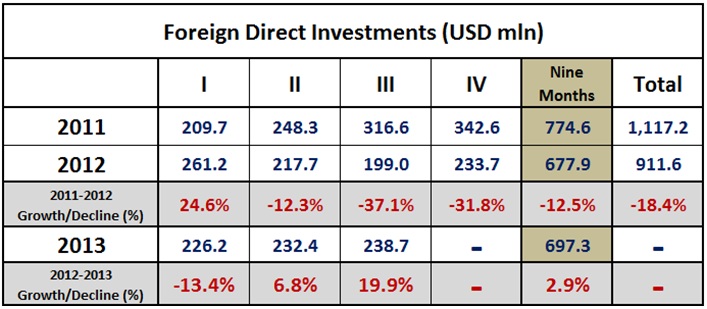 As for trade, to be more precise, the foreign trade (evidently, the MP refers to the latter), we took the largest fields of export and compared the data of 2013 to that of the preceding year. The table below presents the list of ten fields of export whose production is exported in an amount exceeding USD 50 million. Of these ten fields, the export value of eight of them has increased while in two of them the export indices saw a decline.
As for trade, to be more precise, the foreign trade (evidently, the MP refers to the latter), we took the largest fields of export and compared the data of 2013 to that of the preceding year. The table below presents the list of ten fields of export whose production is exported in an amount exceeding USD 50 million. Of these ten fields, the export value of eight of them has increased while in two of them the export indices saw a decline.
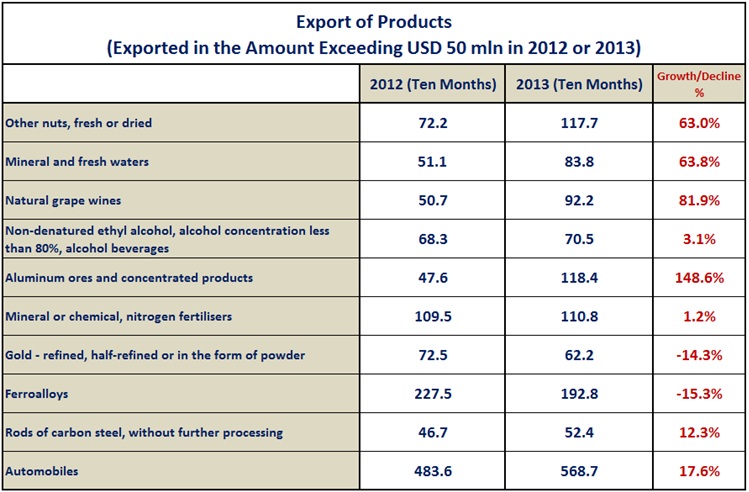 Examining the statistical data of the period after the month of March; that is, the data of the second and third quarters plus the month of October, we see that of the aforementioned ten fields of export, the indicators saw a growth in seven of them while three saw a decline.
Examining the statistical data of the period after the month of March; that is, the data of the second and third quarters plus the month of October, we see that of the aforementioned ten fields of export, the indicators saw a growth in seven of them while three saw a decline.
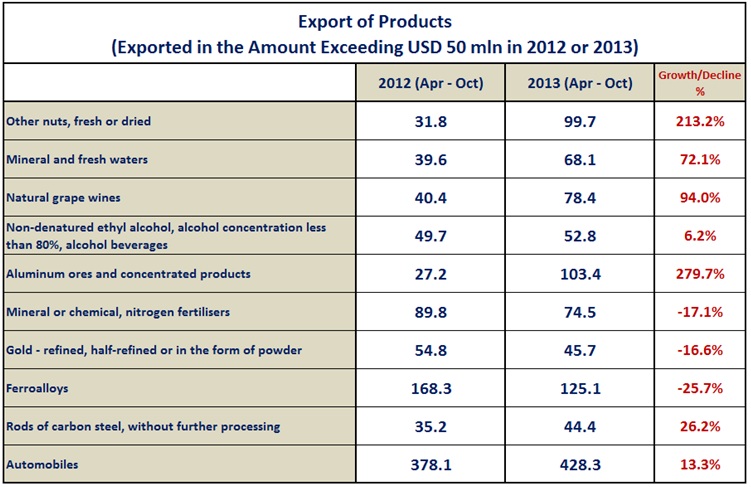 As for the overall export, the indicator for the first ten months of 2013 equalled USD 2,305.9 million which exceeds the indicator of the same period of the previous year by 16.1%. The export value in April-October of 2013 amounted to USD 1,740.4 million which surpasses the indicator of the same period of the previous year by 20.2%.
In 2013 (based upon the data for ten months) export to Russia amounted to USD 130.9 million while in 2012, the same indicator was at USD 37.2 million. In 2013 (based upon the data of ten months) the share of products exported to Russia in the total export of the country amounted to 5.7% while in 2012 the same indicator equalled 1.9%.
According to the statistical data of the period April-October, the export to Russia amounted to USD 116.8 million while in the same period of 2012 the products exported to Russia had a total value of only USD 31.7 million.
As for the overall export, the indicator for the first ten months of 2013 equalled USD 2,305.9 million which exceeds the indicator of the same period of the previous year by 16.1%. The export value in April-October of 2013 amounted to USD 1,740.4 million which surpasses the indicator of the same period of the previous year by 20.2%.
In 2013 (based upon the data for ten months) export to Russia amounted to USD 130.9 million while in 2012, the same indicator was at USD 37.2 million. In 2013 (based upon the data of ten months) the share of products exported to Russia in the total export of the country amounted to 5.7% while in 2012 the same indicator equalled 1.9%.
According to the statistical data of the period April-October, the export to Russia amounted to USD 116.8 million while in the same period of 2012 the products exported to Russia had a total value of only USD 31.7 million.
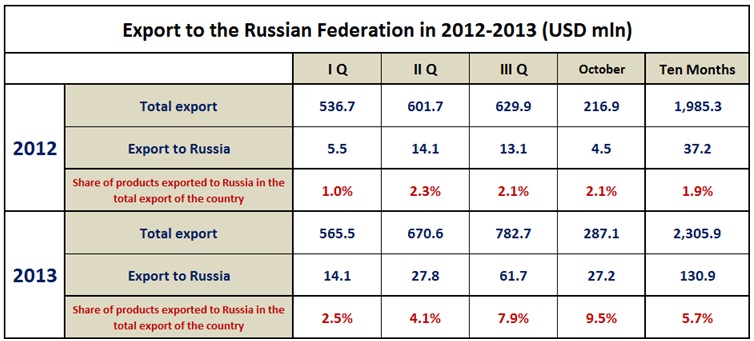
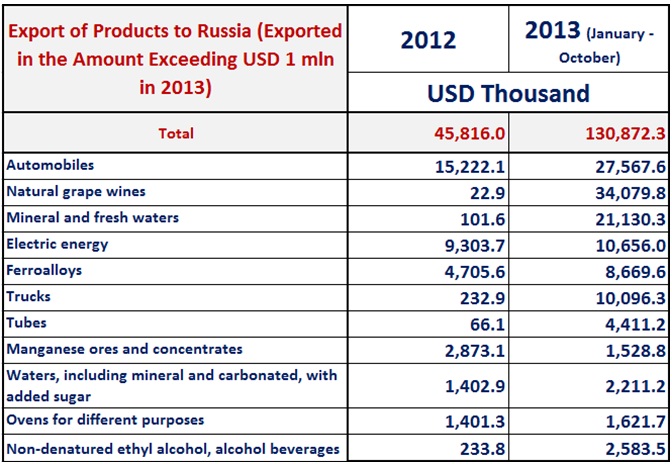 Although the increased volume of products exported to Russia largely contributed to the overall growth of export value in 2013, it is noteworthy that the trade indicators rose with respect to other countries as well. For instance, export to Azerbaijan and Armenia (based upon the comparison of indices of the first ten months of 2013 and the same period of the previous year) grew by USD 58.5 million and USD 47.5 million, respectively, while export to the EU countries rose by USD 156.6 million. It is also to be noted that in line with the data of the first ten months of 2013, export to the USA fell by USD 68.2 million.
In the period between April and October of 2013, Georgia exported products with the total value of USD 1,740.4 million which outstrips the indicator of the preceding year by 20.2%.
Although the increased volume of products exported to Russia largely contributed to the overall growth of export value in 2013, it is noteworthy that the trade indicators rose with respect to other countries as well. For instance, export to Azerbaijan and Armenia (based upon the comparison of indices of the first ten months of 2013 and the same period of the previous year) grew by USD 58.5 million and USD 47.5 million, respectively, while export to the EU countries rose by USD 156.6 million. It is also to be noted that in line with the data of the first ten months of 2013, export to the USA fell by USD 68.2 million.
In the period between April and October of 2013, Georgia exported products with the total value of USD 1,740.4 million which outstrips the indicator of the preceding year by 20.2%.
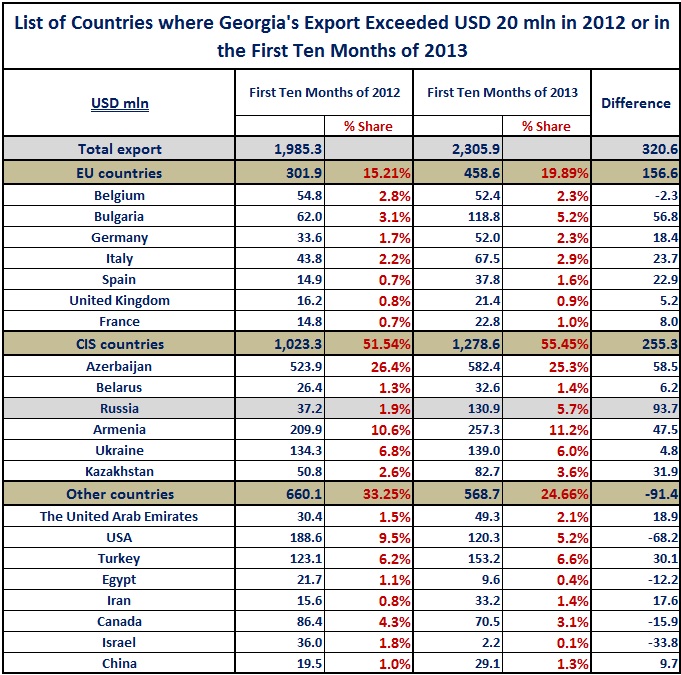 In accordance with the data of the first ten months of 2013, the re-export of automobiles had the total value of USD 568.7 million, taking up 24.7% of Georgia’s overall export, which certainly secures its place as the largest field of export in the country.
The indices of the first ten months of 2013 also reveal an increase of USD 85.1 million in the re-export of automobiles and an increase of USD 50.2 million in April-October.
In accordance with the data of the first ten months of 2013, the re-export of automobiles had the total value of USD 568.7 million, taking up 24.7% of Georgia’s overall export, which certainly secures its place as the largest field of export in the country.
The indices of the first ten months of 2013 also reveal an increase of USD 85.1 million in the re-export of automobiles and an increase of USD 50.2 million in April-October.
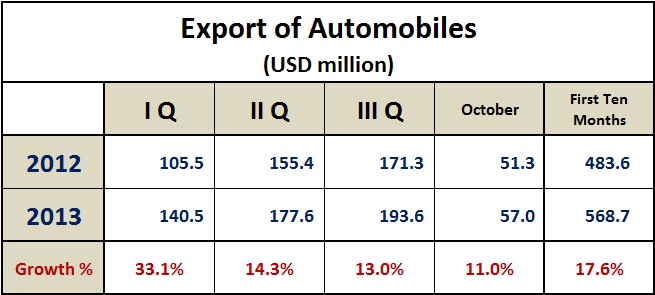 Unlike export, no growth has been observed in the indices of import. Over the period of April-October of 2013, the volume of import amounted to USD 4,704.3 million while the same indicator of 2012 stood at USD 4,810.8 million. As can be seen, import decreased by 2.2% in April-October of 2013. The falling import indices do not denote a downright unfavourable trend, however. The decline of import provides for a growth in net export (export minus import) which on its part prompts a rise in GDP.
Unlike export, no growth has been observed in the indices of import. Over the period of April-October of 2013, the volume of import amounted to USD 4,704.3 million while the same indicator of 2012 stood at USD 4,810.8 million. As can be seen, import decreased by 2.2% in April-October of 2013. The falling import indices do not denote a downright unfavourable trend, however. The decline of import provides for a growth in net export (export minus import) which on its part prompts a rise in GDP.
 Conclusion
In the period following March of 2013 the indices for total export and foreign direct investment took an upturn. In April-October of 2013, FDI rose by USD 54.4 million (13%) as compared to the same period of 2012 while export grew by USD 291.9 million (20.2%). Therefore, this part of the MP’s statement is inaccurate.
The downturn in import represents a more controversial matter. In his statement the MP emphasises the decline in trade but the pathos of the statement also describes the fall in the import indices as an undoubtedly negative occurrence which is not correct. The rise in export and the decline in import observed in April-October of 2013 provided for an increase in net export (export minus import) and, therefore, for the growth of GDP as well.
Export to Russia grew by USD 85.1 million (268.5%) in April-October of 2013 while the re-export of automobiles surged by USD 50.2 million (13.3%). The upturn in the re-export of automobiles as well as the opening of the Russian market contributed greatly to the overall growth of export. But this contribution was not decisive as the export of other products grew as well (the export of nuts increased by USD 67.9 million, mineral waters – USD 28.5 million, wine – USD 38 million, aluminium – USD 76.2 million) and produced an increase of USD 292 million in export by the end of the April-October period of 2013. Subsequently, although the re-export of automobiles undoubtedly represents the largest field of export in Georgia, this part of the MP’s statement is not entirely accurate.
We conclude that Petre Tsiskarishvili’s statement: “After the constitutional amendment introduced in March, the volume of investments did not increase, nor did [foreign] trade, except for very specific fields of export which were encouraged, on the one hand, by Russia, and, on the other, by the automobile trade hub in Rustavi established by the man who you are holding captive in Matrosovi prison. Trade and the re-export of automobiles tops the list of exported goods in the Georgian economy,” is MOSTLY FALSE.
Conclusion
In the period following March of 2013 the indices for total export and foreign direct investment took an upturn. In April-October of 2013, FDI rose by USD 54.4 million (13%) as compared to the same period of 2012 while export grew by USD 291.9 million (20.2%). Therefore, this part of the MP’s statement is inaccurate.
The downturn in import represents a more controversial matter. In his statement the MP emphasises the decline in trade but the pathos of the statement also describes the fall in the import indices as an undoubtedly negative occurrence which is not correct. The rise in export and the decline in import observed in April-October of 2013 provided for an increase in net export (export minus import) and, therefore, for the growth of GDP as well.
Export to Russia grew by USD 85.1 million (268.5%) in April-October of 2013 while the re-export of automobiles surged by USD 50.2 million (13.3%). The upturn in the re-export of automobiles as well as the opening of the Russian market contributed greatly to the overall growth of export. But this contribution was not decisive as the export of other products grew as well (the export of nuts increased by USD 67.9 million, mineral waters – USD 28.5 million, wine – USD 38 million, aluminium – USD 76.2 million) and produced an increase of USD 292 million in export by the end of the April-October period of 2013. Subsequently, although the re-export of automobiles undoubtedly represents the largest field of export in Georgia, this part of the MP’s statement is not entirely accurate.
We conclude that Petre Tsiskarishvili’s statement: “After the constitutional amendment introduced in March, the volume of investments did not increase, nor did [foreign] trade, except for very specific fields of export which were encouraged, on the one hand, by Russia, and, on the other, by the automobile trade hub in Rustavi established by the man who you are holding captive in Matrosovi prison. Trade and the re-export of automobiles tops the list of exported goods in the Georgian economy,” is MOSTLY FALSE.
 As for trade, to be more precise, the foreign trade (evidently, the MP refers to the latter), we took the largest fields of export and compared the data of 2013 to that of the preceding year. The table below presents the list of ten fields of export whose production is exported in an amount exceeding USD 50 million. Of these ten fields, the export value of eight of them has increased while in two of them the export indices saw a decline.
As for trade, to be more precise, the foreign trade (evidently, the MP refers to the latter), we took the largest fields of export and compared the data of 2013 to that of the preceding year. The table below presents the list of ten fields of export whose production is exported in an amount exceeding USD 50 million. Of these ten fields, the export value of eight of them has increased while in two of them the export indices saw a decline.
 Examining the statistical data of the period after the month of March; that is, the data of the second and third quarters plus the month of October, we see that of the aforementioned ten fields of export, the indicators saw a growth in seven of them while three saw a decline.
Examining the statistical data of the period after the month of March; that is, the data of the second and third quarters plus the month of October, we see that of the aforementioned ten fields of export, the indicators saw a growth in seven of them while three saw a decline.
 As for the overall export, the indicator for the first ten months of 2013 equalled USD 2,305.9 million which exceeds the indicator of the same period of the previous year by 16.1%. The export value in April-October of 2013 amounted to USD 1,740.4 million which surpasses the indicator of the same period of the previous year by 20.2%.
In 2013 (based upon the data for ten months) export to Russia amounted to USD 130.9 million while in 2012, the same indicator was at USD 37.2 million. In 2013 (based upon the data of ten months) the share of products exported to Russia in the total export of the country amounted to 5.7% while in 2012 the same indicator equalled 1.9%.
According to the statistical data of the period April-October, the export to Russia amounted to USD 116.8 million while in the same period of 2012 the products exported to Russia had a total value of only USD 31.7 million.
As for the overall export, the indicator for the first ten months of 2013 equalled USD 2,305.9 million which exceeds the indicator of the same period of the previous year by 16.1%. The export value in April-October of 2013 amounted to USD 1,740.4 million which surpasses the indicator of the same period of the previous year by 20.2%.
In 2013 (based upon the data for ten months) export to Russia amounted to USD 130.9 million while in 2012, the same indicator was at USD 37.2 million. In 2013 (based upon the data of ten months) the share of products exported to Russia in the total export of the country amounted to 5.7% while in 2012 the same indicator equalled 1.9%.
According to the statistical data of the period April-October, the export to Russia amounted to USD 116.8 million while in the same period of 2012 the products exported to Russia had a total value of only USD 31.7 million.

 Although the increased volume of products exported to Russia largely contributed to the overall growth of export value in 2013, it is noteworthy that the trade indicators rose with respect to other countries as well. For instance, export to Azerbaijan and Armenia (based upon the comparison of indices of the first ten months of 2013 and the same period of the previous year) grew by USD 58.5 million and USD 47.5 million, respectively, while export to the EU countries rose by USD 156.6 million. It is also to be noted that in line with the data of the first ten months of 2013, export to the USA fell by USD 68.2 million.
In the period between April and October of 2013, Georgia exported products with the total value of USD 1,740.4 million which outstrips the indicator of the preceding year by 20.2%.
Although the increased volume of products exported to Russia largely contributed to the overall growth of export value in 2013, it is noteworthy that the trade indicators rose with respect to other countries as well. For instance, export to Azerbaijan and Armenia (based upon the comparison of indices of the first ten months of 2013 and the same period of the previous year) grew by USD 58.5 million and USD 47.5 million, respectively, while export to the EU countries rose by USD 156.6 million. It is also to be noted that in line with the data of the first ten months of 2013, export to the USA fell by USD 68.2 million.
In the period between April and October of 2013, Georgia exported products with the total value of USD 1,740.4 million which outstrips the indicator of the preceding year by 20.2%.
 In accordance with the data of the first ten months of 2013, the re-export of automobiles had the total value of USD 568.7 million, taking up 24.7% of Georgia’s overall export, which certainly secures its place as the largest field of export in the country.
The indices of the first ten months of 2013 also reveal an increase of USD 85.1 million in the re-export of automobiles and an increase of USD 50.2 million in April-October.
In accordance with the data of the first ten months of 2013, the re-export of automobiles had the total value of USD 568.7 million, taking up 24.7% of Georgia’s overall export, which certainly secures its place as the largest field of export in the country.
The indices of the first ten months of 2013 also reveal an increase of USD 85.1 million in the re-export of automobiles and an increase of USD 50.2 million in April-October.
 Unlike export, no growth has been observed in the indices of import. Over the period of April-October of 2013, the volume of import amounted to USD 4,704.3 million while the same indicator of 2012 stood at USD 4,810.8 million. As can be seen, import decreased by 2.2% in April-October of 2013. The falling import indices do not denote a downright unfavourable trend, however. The decline of import provides for a growth in net export (export minus import) which on its part prompts a rise in GDP.
Unlike export, no growth has been observed in the indices of import. Over the period of April-October of 2013, the volume of import amounted to USD 4,704.3 million while the same indicator of 2012 stood at USD 4,810.8 million. As can be seen, import decreased by 2.2% in April-October of 2013. The falling import indices do not denote a downright unfavourable trend, however. The decline of import provides for a growth in net export (export minus import) which on its part prompts a rise in GDP.
 Conclusion
In the period following March of 2013 the indices for total export and foreign direct investment took an upturn. In April-October of 2013, FDI rose by USD 54.4 million (13%) as compared to the same period of 2012 while export grew by USD 291.9 million (20.2%). Therefore, this part of the MP’s statement is inaccurate.
The downturn in import represents a more controversial matter. In his statement the MP emphasises the decline in trade but the pathos of the statement also describes the fall in the import indices as an undoubtedly negative occurrence which is not correct. The rise in export and the decline in import observed in April-October of 2013 provided for an increase in net export (export minus import) and, therefore, for the growth of GDP as well.
Export to Russia grew by USD 85.1 million (268.5%) in April-October of 2013 while the re-export of automobiles surged by USD 50.2 million (13.3%). The upturn in the re-export of automobiles as well as the opening of the Russian market contributed greatly to the overall growth of export. But this contribution was not decisive as the export of other products grew as well (the export of nuts increased by USD 67.9 million, mineral waters – USD 28.5 million, wine – USD 38 million, aluminium – USD 76.2 million) and produced an increase of USD 292 million in export by the end of the April-October period of 2013. Subsequently, although the re-export of automobiles undoubtedly represents the largest field of export in Georgia, this part of the MP’s statement is not entirely accurate.
We conclude that Petre Tsiskarishvili’s statement: “After the constitutional amendment introduced in March, the volume of investments did not increase, nor did [foreign] trade, except for very specific fields of export which were encouraged, on the one hand, by Russia, and, on the other, by the automobile trade hub in Rustavi established by the man who you are holding captive in Matrosovi prison. Trade and the re-export of automobiles tops the list of exported goods in the Georgian economy,” is MOSTLY FALSE.
Conclusion
In the period following March of 2013 the indices for total export and foreign direct investment took an upturn. In April-October of 2013, FDI rose by USD 54.4 million (13%) as compared to the same period of 2012 while export grew by USD 291.9 million (20.2%). Therefore, this part of the MP’s statement is inaccurate.
The downturn in import represents a more controversial matter. In his statement the MP emphasises the decline in trade but the pathos of the statement also describes the fall in the import indices as an undoubtedly negative occurrence which is not correct. The rise in export and the decline in import observed in April-October of 2013 provided for an increase in net export (export minus import) and, therefore, for the growth of GDP as well.
Export to Russia grew by USD 85.1 million (268.5%) in April-October of 2013 while the re-export of automobiles surged by USD 50.2 million (13.3%). The upturn in the re-export of automobiles as well as the opening of the Russian market contributed greatly to the overall growth of export. But this contribution was not decisive as the export of other products grew as well (the export of nuts increased by USD 67.9 million, mineral waters – USD 28.5 million, wine – USD 38 million, aluminium – USD 76.2 million) and produced an increase of USD 292 million in export by the end of the April-October period of 2013. Subsequently, although the re-export of automobiles undoubtedly represents the largest field of export in Georgia, this part of the MP’s statement is not entirely accurate.
We conclude that Petre Tsiskarishvili’s statement: “After the constitutional amendment introduced in March, the volume of investments did not increase, nor did [foreign] trade, except for very specific fields of export which were encouraged, on the one hand, by Russia, and, on the other, by the automobile trade hub in Rustavi established by the man who you are holding captive in Matrosovi prison. Trade and the re-export of automobiles tops the list of exported goods in the Georgian economy,” is MOSTLY FALSE.







